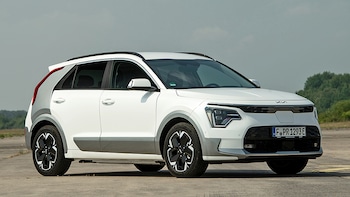Kia Niro EV convinces with a fair price-performance ratio
The fact that it still feels airier is also due to the new front seats, which have become significantly slimmer. A circumstance that also pleases travelers in the second row, as their knees are no longer in danger of coming under pressure.
Family friend: The trunk of the new Niro EV has grown by 24 liters and there is plenty of space in the back seat.
In addition, two USB charging ports in the side bolsters of the front seats ensure the power supply for the smartphones of young people, while the rear seat backrest, which can be adjusted over three levels, guarantees casual hanging out.
Travel comfortably in the Niro EV
The head of the family can also sit back and relax when it comes to luggage. Not only that the trunk with 475 liters has grown by 24 liters compared to its predecessor, the Niro can now take at least 750 kilograms on the hook. If the rear seat backrest is made completely flat, there is 1392 liters of storage space on the flat loading area. The luggage compartment is released via a sensor-controlled tailgate, which opens with a loud beep when the key holder is in front of it.
engine
installation position
Top performance
continuous power
Max. Torque
battery type
Battery capacity (net)
Charging power AC/DC
Charging time (10-80%, DC charging)
charging port
V max
drive
Brakes front/rear
test car tires
tire type
wheel size
Exhaust gas CO2 (local)
Consumption*
Range*
pass-by noise
trailer load used/unused
drawbar load
trunk volume
Length Width Height
wheelbase
Basic price (before funding)
Test car price (is evaluated)
There is also - and this is also new - a 20 liter “Frunk” under the front hood. That’s enough for small items or for the charging cable. The latter is in good hands there, because the standard three-phase on-board charger is located where the radiator grille is on combustion engines.
WLTP vs. reality: Kia promises a range of 460 kilometers, in our test drives the Niro EV managed 100 kilometers less.
The Kia does not achieve the WLTP range
Charged: A column with an output of 80 kW fills the 64.8 kWh battery from 10 to 80 percent in around 45 minutes.
In this respect, you can travel quickly on the autobahn at a speed of 140 km/h and drive from Hamburg to Potsdam (295 kilometers) without a charging stop, in order to roll to a charging station there with a remaining range of around 20 kilometers.
acceleration
0-50km/h
0-100km/h
0-130km/h
0-160km/h
intermediate sprint
60-100km/h
80-120km/h
curb weight/load
Weight distribution v./h.
Turning circle left/right
seat height
braking distance
from 100 km/h cold
from 100 km/h warm
interior noise
at 50 km/h
at 100 km/h
at 130 km/h
consumption
saving consumption
test consumption
Average of the 155 km test lap (deviation from the WLTP specification)
sports consumption
CO2 (test consumption)
Range (test consumption)
A fast charger is recommended here, because the 64.8 kWh battery of the Niro EV (0.8 kWh more than its predecessor) can be charged with up to 80 kW direct current. So if you dock at the right station, you can fill the battery from 10 to 80 percent in just under 45 minutes.
Recuperation brings noticeably more kilometers
There is praise for the intelligent recuperation, which can be activated by pulling the left paddle shifter on the steering wheel. Here the use of the brake pedal is almost completely eliminated, and the returned energy is actually noticeable in the range.
It would be nice if that navigation system of the Niro EV would be able to reliably display all charging stations on the route and would also be able to tell with certainty whether a charging station was defective or occupied. Otherwise, the possible preconditioning of the battery to an ideal 20 to 25 degrees makes little sense.
Designed to be more comfortable: the steering of the Niro EV remains low in feedback – the sport mode doesn’t change that either.
Like its predecessor, the EV is powered by a permanent magnet synchronous motor that produces 204 hp. However, the engineers throttled the maximum torque from 395 to 255 Newton meters. It sounds bad, but the crossover suits it much better because it doesn’t tiresomely paw the hooves when starting off at traffic lights. The start is a bit more restrained, but with 7.5 seconds from zero to 100 km/h the 1.7 ton Kia still starts properly.
Sportiness is far from the Niro
Noise spoils the impression of quality
It’s a pity that it rustles and rustles from the fittings and the rear area when running over cobblestones. This clouds the impression that the otherwise well-made Stromer makes and somehow contradicts the pleasant atmosphere that the interior, which is made of recycled materials, exudes. Whether you get used to the greasy finger-sensitive door panels and the piano lacquer inlays in the center console probably depends on the owner’s willingness to clean.
Not really whisper-quiet: There are noises from the interior when driving over cobblestones.
All in all, the Kia Niro EV makes a modern and contemporary impression, which is also supported by the lavish range of assistance systems. With a price starting at 47,590 euros, the Korean has become a bit more expensive, but it already shines with a lavish standard equipment. It is also important to deduct the environmental bonus here.
body
drive
driving dynamics
connected car
environment
Comfort
Costs
AUTO BILD test score
In this respect, Kia has definitely succeeded in offering a family-friendly electricity (er) tariff. This is not only supported by a seven-year guarantee (which also applies to the battery), but also by long service intervals every two years or after 30,000 kilometers.




